________________
196
THE INDIAN ANTIQUARY.
नारकी ॥ चार लाख तियेच पंचेंद्री ॥ चोद लाख मनुष्य एवंकारे ॥ चौरासी लाख जीवा योनी माहिं ॥ माहरे जीने जे काइ जीन । हण्डी होय रागाव्य होय ॥ हणाता प्रत्ये अनुमोद्यो होय ।। ते सव्वे हुं मन वचन कायाए करी ॥ मिच्छामि दुक्कडं । इति
अथ अढार पापस्थानक
वेहेले प्राणातिपात ॥ बीजे मृषावाद, वीजे अदत्तादान चोथे मैथुन, पांचमे परिग्रह, चट्ठे क्रोध, सातमे मान, आठमे माया, नवमें लोभ, दशमे राग, इग्यारमे द्वेष, बारमे कलह, तेरमें अभ्याख्यान, चौदमे पैशून, पन्नरमे रति अरति सोलने परपरिवाद, सत्तरमे मायामृषावाद, अढारमे मिथ्यात्वशल्य, ए अढार पापस्थानमा हिं मारे जीवे जे कोइ सेव्यं होय ॥ सेवराज्यं होय, सेवतां मेते अनुमो होय, ते सने हुं मन वचन कायाए करी ।। तस्स मिच्छामि दुबई ॥ इति ॥
"
अथ सव्वस्सवि
सव्वस्सवि देवसिअ दुश्चिति ॥ दुष्भासिअ दुच्चि - द्विअ || इच्छाकारेण संदिसह भगवन इच्छं । तस्स मिच्छमि दुकडे ॥ इति ॥
On this day the Kalpasútra is read from beginning to end without comment of any kind.
Of the other seasons the Kárttikini festival begins on the 7th of the Krishnapaksha of Karttika, and lasts till the full-moon.
Phálgun-chaumásuh lasts from the 7th of the Krishnapaksha of Phalguna till the fullmoon following. Asháḍha-chaumásum is from the 7th of the Krishnapaksha of Ashadha to the full-moon of that month. The Abilani Oli in Asvina, from the 7th of the Krishnapaksha of Aévina to the following full-moon. The Ambilani Oli in Chaitra from the 7th of the Krishnapaksha of Chaitra to the full-moon of that month.
It is incumbent on all Śrâvakas, whether they attend to daily services in the temples or
[JULY, 1884.
not, to observe these days. They also go to the Upásaras or monasteries to hear the Angas of the Kalpasútra read.
They worship the Siddhachakra on these days. On a small silver or brass stand are four figures in relief seated cross-legged like the Jainas, one in the centre, and four round the circumference. Between the latter are the words Dariana, Jñána, Chaitra, and Tapus. The five figures represent the five orders of Jaina saints-first, the Arhat in the centre; second,
the Siddha above; third, the Acharya to the worshipper's right; fourth, the Muni or Sádhu to his left; and fifth, the Upadhyaya below.
By the more rigid Jainas fasting is observed on these days. There are several kinds of
fastings. – (1), Upavasä, of which, again, there
are two divisions-Chauvihar and Tévihár--the former is abstinence from food and water, and the latter from food and taking water that has been boiled and cooled, during daylight after 10 A.M. and before sunset; (2), Ékásana, in which he may eat as much as he likes, sitting on one ásana. Vegetables, either cooked or raw are prohibited. He must eat only grain, cooked of course, and drink water that has been boiled and cooled; (3), Ambil, in which he eats his usual food, seated on one ásana, but must not taste oil and ghi or fatty substances; (4), Niví, in addition to Ambil, he may eat sour substances; (5), Bé-ásano, is the same as Ékúsana, but in this he may eat twice; (6); Chhat-like Upavásá, this is of two kinds-Chauvihar and Tévihár; the former is abstaining from food and water for two days, and the latter is abstaining from food alone for the same period; (7), Attam, is similar to the preceding, but the abstinence continues for three consecutive days. And thus the fasts may be observed from 4, 5, 6, 7, &c., consecutive days to a month. A fortnight's fast is called Pakshamana. Fasting for a month is called Másakamana."
CHINGHIZ KHAN AND HIS ANCESTORS. BY HENRY H. HOWORTH, F.S.A. (Continued from p. 148 ante.)
XXVI. Chinghiz Khân spent the summer of 1219 in the fine pastures of the Irtish, so as to
For the information contained in this paper I am indebted to the kindness of Dholsa Hakam Chand Dalal,
get. his horses in good condition for his great campaign in the west. Before he started, we read in the Yuan-ch'ao-pi-shi, his wife, Yesui,
and his son Daby&bhai phôlsa Dalal.




